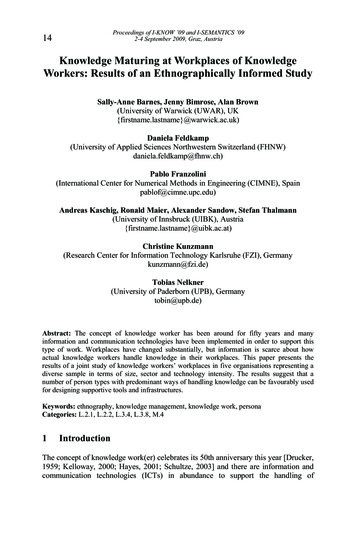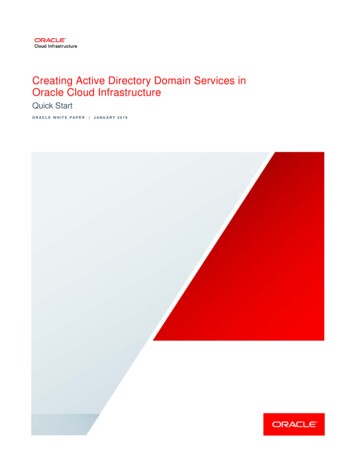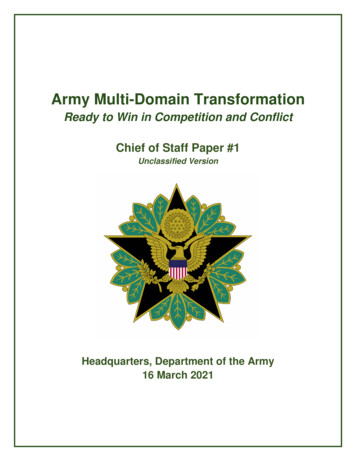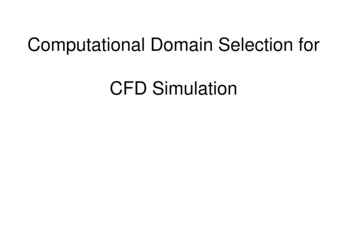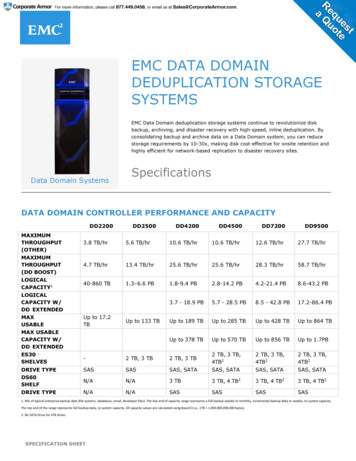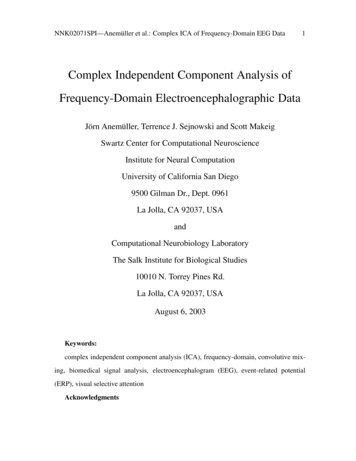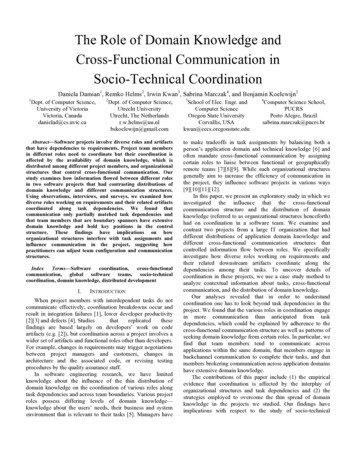
Transcription
The Role of Domain Knowledge andCross-Functional Communication inSocio-Technical CoordinationDaniela Damian1, Remko Helms2, Irwin Kwan3, Sabrina Marczak4, and Benjamin Koelewijn21Dept. of Computer Science,University of VictoriaVictoria, Canadadanielad@cs.uvic.ca2Dept. of Computer Science,Utrecht UniversityUtrecht, The tract—Software projects involve diverse roles and artifactsthat have dependencies to requirements. Project team membersin different roles need to coordinate but their coordination isaffected by the availability of domain knowledge, which isdistributed among different project members, and organizationalstructures that control cross-functional communication. Ourstudy examines how information flowed between different rolesin two software projects that had contrasting distributions ofdomain knowledge and different communication structures.Using observations, interviews, and surveys, we examined howdiverse roles working on requirements and their related artifactscoordinated along task dependencies. We found thatcommunication only partially matched task dependencies andthat team members that are boundary spanners have extensivedomain knowledge and hold key positions in the controlstructure. These findings have implications on howorganizational structures interfere with task assignments andinfluence communication in the project, suggesting howpractitioners can adjust team configuration and ination,cross-functionalcommunication, global software teams, socio-technicalcoordination, domain knowledge, distributed developmentI.INTRODUCTIONWhen project members with interdependent tasks do notcommunicate effectively, coordination breakdowns occur andresult in integration failures [1], lower developer productivity[2][3] and defects [4]. Studiesthatreplicatedthesefindings are based largely on developers’ work on codeartifacts (e.g. [2]), but coordination across a project involves awider set of artifacts and functional roles other than developers.For example, changes in requirements may trigger negotiationsbetween project managers and customers, changes inarchitecture and the associated code, or revising testingprocedures by the quality assurance staff.In software engineering research, we have limitedknowledge about the influence of the thin distribution ofdomain knowledge on the coordination of various roles alongtask dependencies and across team boundaries. Various projectroles possess differing levels of domain knowledge—knowledge about the users’ needs, their business and systemenvironment that is relevant to their tasks [5]. Managers have3School of Elec. Engr. andComputer ScienceOregon State UniversityCorvallis, USAkwan@eecs.oregonstate.edu4Computer Science School,PUCRSPorto Alegre, Brazilsabrina.marczak@pucrs.brto make tradeoffs in task assignments by balancing both aperson’s application domain and technical knowledge [6] andoften mandate cross-functional communication by assigningcertain roles to liaise between functional or geographicallyremote teams [7][8][9]. While such organizational structuresgenerally aim to increase the efficiency of communication inthe project, they influence software projects in various ways[9][10][11][12].In this paper, we present an exploratory study in which weinvestigated the influence that the cross-functionalcommunication structure and the distribution of domainknowledge (referred to as organizational structures henceforth)had on coordination in a software team. We examine andcontrast two projects from a large IT organization that haddifferent distributions of application domain knowledge anddifferent cross-functional communication structures thatcontrolled information flow between roles. We specificallyinvestigate how diverse roles working on requirements andtheir related downstream artifacts coordinate along thedependencies among their tasks. To uncover details ofcoordination in these projects, we use a case study method toanalyze contextual information about tasks, cross-functionalcommunication, and the distribution of domain knowledge.Our analyses revealed that in order to understandcoordination one has to look beyond task dependencies in theproject. We found that the various roles in coordination engagein more communication than anticipated from taskdependencies, which could be explained by adherence to thecross-functional communication structure as well as patterns ofseeking domain knowledge from certain roles. In particular, wefind that team members tend to communicate acrossapplications within the same domain, that members engage inbackchannel communication to complete their tasks, and thatmembers brokering communication across application domainshave extensive domain knowledge.The contributions of this paper include (1) the empiricalevidence that coordination is affected by the interplay oforganizational structures and task dependencies and (2) thestrategies employed to overcome the thin spread of domainknowledge in the projects we studied. Our findings haveimplications with respect to the study of socio-technical
coordination to account for these additional organizationalstructures, and configuring teams to optimize the disseminationof domain knowledge in software projects.II.RELATED WORK AND RESEARCH QUESTIONSResearch into software team coordination has confirmedthat aligning organizational factors and technical factors affectssoftware quality and cost [1][2][13][14]. In particular, theseresearchers have analyzed socio-technical alignment, whichexamines how the technical aspects of software engineering arematched by the work-related interactions of softwaredevelopers. One measure of socio-technical alignment is sociotechnical congruence (STC) [2], which calculates thealignment of actual communication with the anticipatedcoordination needs of team members based on technical taskassignments and task dependencies. Applications of thisapproach yielded significant empirical evidence aboutcoordination in software development—higher socio-technicalcongruence generally correlates with higher developerproductivity [2] and reduced integration failures [1]. Managersand researchers could use STC to diagnose and improve teamcoordination [13].However, most research on socio-technical alignment hasbeen focused on developers’ work from repositories anddevelopment artifacts such as code [4], defects [15] or softwarebuilds [1]; studies of coordination in open-source tend to focuson developers as well (e.g. [16]). This focus on code anddefects overlooks the coordination that takes place within awider set of stakeholders such as business analysts, testers,requirements analysts and project managers. A way to studycoordination between diverse roles is to look at a higher levelof abstraction: requirements.Requirements are central elements in project planning andresourcing and provide a focal point around which teammembers coordinate their tasks [15][17][18]. Requirementscreate dependencies among downstream artifacts such asdesign, architecture, code, and test cases. Environments (e.g.[19]) now leverage traceability links between requirements andthese associated artifacts to enable collaboration and softwaregovernance throughout the entire project life cycle. Recentstudies found that communication driven by requirements takesplace within cross-functional teams involving developers,business analysts and testers [17][20] and that the mostpredominant reason for communication was changes inrequirements [21].Despite this evidence, we have limited knowledge as towhether the communication of these multiple roles aligns withtheir task dependencies and consequently about the role of taskassignments in coordination. To complete their tasks, teammembers often stretch their communication by reaching out tothose that possess in-depth domain knowledge across differentteams and geographical locations [7]. Therefore, our firstresearch question is exploratory and seeks to unveil details ofthe elements of the socio-technical alignment of softwareteams, namely the task dependencies as well as thecommunication of the wider set of stakeholders:RQ1: What is the nature of task dependencies, projectcommunication and socio-technical alignment in arequirements view on coordination?Organizational structures that control cross-functionalcommunication is one factor that may influence thecommunication among the various stakeholders. Such astructure typically introduces a hierarchy in which certainorganizational roles control information flow within and acrossteams or departments [25]. These hierarchies and groups existin all kinds of project sizes [16]. Bird et al. [10] identified thatin popular open-source software projects, communication wascentered on small, interoperating groups of developers, andHinds and McGrath [9] observed that dense structures tendedto be associated with communication problems. In contrast,Cataldo and Ehrlich found that hierarchical networks deliveredmore features than close-knit networks but had lower quality[11]. Social network analysis has also been used to identify arelationship between communication structure and softwarequality [1][14]. Although organizational structures aim toprevent communication issues and increase communicationefficiency [25], they may also impede knowledge flow if thestructure is not defined according to task assignments, andstudies of organizational behavior document the role ofinformal networks in task accomplishment (e.g. [27][28]). Thisleads us to our second research question:RQ2: How does the cross-functional communication structureinfluence actual communication of various roles incoordination?Involving multiple functional roles also introducesdifferences in domain knowledge within the team. Domainknowledge is the implicit knowledge about client needs, theirbusiness domain and the system’s environment [29].Communicating domain knowledge to others improves team’sunderstanding and can increase team buy-in [30]. The domainexpert often brokers knowledge across geographical boundaries[8] or roles [31], bridges gaps between people that areotherwise not communicating [7][32][31], and is able topromote innovation [22][33]. Often, the domain expert doesnot plan to be in this brokering position, which leads to limitedaccess to that expert [6][30]. Thus, coordination andcommunication patterns within projects may not align with taskcoordination and instead follow informal connections governedby domain expertise [27][28]. A requirements perspective oncoordination allows us to examine communication driven bythe distribution of domain knowledge in the project.RQ3: How does the spread of domain knowledge influencecommunication of various roles in coordination?
III.RESEARCH METHODOLOGYWe used a multiple case study methodology [34] and acombination of quantitative and qualitative data collectionmethods to study coordination in two projects called SHIP andAPP within a large multinational organization that we callORG. ORG develops software applications to support itsprimary business of selling and supporting IT equipment. ORGreleases quarterly versions of its software applications, whichare organized in portfolios according to the ORG business areathey serve. ORG’s headquarters are in the United States, whileits development centers are located in the United States, Brazil,India, and Russia.SHIP and APP serve different business areas within ORGand, at the time of our study, had different team configurationsin the US and the offshore locations, different distributions ofapplication domain knowledge among its members, as well asdifferent cross-functional communication structures to copewith its newly formed relationship with Brazil and India. Bothproject teams were considered successful, delivering on timeand on-budget.A. Project DescriptionsThe SHIP project enhanced and maintained a criticalinternal software application supporting ORG's shippingprocess. The application was eight years old and wasoutsourced to Brazil three years prior to our study. Weinvestigated a four-month release during which the applicationwas updated to accommodate changes in ORG’s businessprocess and the database infrastructure.Project team configuration. The project team (14 persons)consisted of its original four members in US: system architect,developer leader, and 2 developers, and 10 newly hiredmembers in Brazil: developer leader, test leader, 5 developersand 3 testers. In Brazil, the team was distributed across threebuildings on-site. Additionally there were 3 business partnerslocated in the United States who acted as customers for theapplication. They were representatives of ORG’s shippingproduction team (e.g. logistic manager and environmentcoordinator) who worked together with the ORG ITinfrastructure team.Knowledge about the application and its domain. Thisteam had access to up-to-date project documentation detailingits requirements and architecture. The team could also accessthe application’s domain knowledge through the Americandeveloper leader, system architect and a senior developeroriginally involved in the application’s inception. NewBrazilian hires travelled to the United States development sitefor six months for training. Developer leaders were in chargeof gathering and negotiating requirements for new releaseswith the internal customers. The project manager’sresponsibility was to manage the schedule, resources, andbudget. The system architect supported the developer leadersregarding architecture, though this did not often occur in thisiteration due to the few architecture changes.Cross-functional communication structure. SHIP’scommunication structure is illustrated in Fig. 1b (legend for allour networks is in Fig. 1a). The symbols represent team roles;TABLE I. ANONYMIZED SAMPLE REQUIREMENTSSHIP projectChange shipping labelto a new standardAllowemailnotification when orderhas been shipped or isavailable for
have extensive domain knowledge. The contributions of this paper include (1) the empirical evidence that coordination is affected by the interplay of organizational structures and task dependencies and (2) the strategies employed to overcome the thin spread of domain knowledge in
